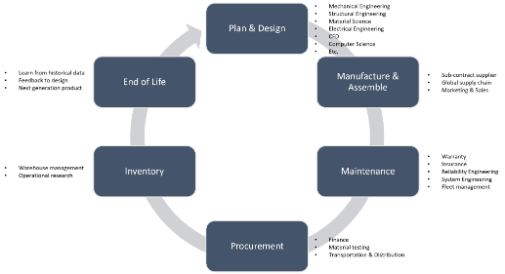Reliability-Centered Industrial Recommender System for Aircraft Fleet Fast Response Capabilities
The civil aviation industry is a complex operation, involving highly complex engineering systems and asset-heavy businesses. Optimized fleet life-cycle management is crucial yet challenging, given the critical operational conditions, high-standard reliability demands, and high costs in asset value and through-life maintenance services. To maintain performance and the time-on-wing requirements of airline operators, civil aircraft engines typically require three to four highly costly overhauls throughout their service life. Multiple levels of maintenance activities need accurate and long-term planning for engine fleets, including manufacturing, transportation, supply chains, and system performance based on the service life of the engines.
In everyday operations, unplanned events happen, and decisions must be made to maintain the airworthiness of both aircraft and propulsion systems. Currently, human-centric decision-making is taken under constraints of time and resources, primarily relying on the personal experience of professionals at hangers, depots, air-bases, and overhaul facilities. However, the difficulty to justify the long-term impact under emergency conditions leads to potential safety and risk to aviation airworthiness, which may lead to disastrous consequences, as well as sustainable business operations.
A solution to this problem is industrial recommender systems, which assist decision-making under pressure by optimizing limited resources and minimizing the long-term negative impact. To significantly improve the reliability evaluation of the highly demanding aviation system and generate more Time-on-Wing for sustainable business operations, a series of works have been explored and published on transforming the existing operation life evaluation of civil aircraft engines from a single dimension to a multi-dimensional approach. This research output is highly evaluated by the industry in both civil aviation and defence sectors.
The project is an integration module towards asset life-cycle management, overview in the figure below:

Figure 1: Aviation asset life-cycle management demonstration
Our research is geared towards the deployment of innovative digital solutions, with a primary focus on enhancing human-machine interactions tailored for industrial applications. We aim to integrate sophisticated algorithms alongside advanced mathematical and statistical models, thereby optimizing decision-making processes and developing a robust, automated action recommendation system.
Additionally, we are committed to exploring and leveraging our digital infrastructure, which includes our team's industry-leading dedicated server, an array of Internet of Things (IoT) devices, and state-of-the-art Non-Destructive Testing (NDT) equipment. Our goal is to develop data-centric solutions that not only facilitate efficient AI training but also enhance inferencing capabilities, thereby advancing the frontier of technology in practical applications.
Extensive topics:
- Maintenance Policy Modelling: Building on our quantified airworthiness model, we evaluate the reliability of civil aircraft engine systems. Our approach considers maintenance capability constraints and optimizes the scheduling of hierarchical maintenance checks throughout an engine's life cycle. This extends to formulating optimal maintenance policies for larger fleets, aiming to maximize availability for airline operators and manufacturers. Our research findings offer significant operational time increases and reduce unplanned heavy maintenance, addressing key aftersales service supply chain questions: when, where, and how many spare parts are required.
- Business Modeling & Risk Management: Expanding on our system reliability and risk models, we investigate novel business model updates for aviation firms (both manufacturers and operators) to stay competitive and resilient against sudden impacts. Additionally, we delve into asset pricing and aftersales service valuation, along with insurance strategies for high-value aviation assets.
Quick links
- High Reynolds number flows for aerospace and automotive applications
- Electrification and cryo-electrification of powertrain and drivetrain components
- Engineering in Extreme Environments
- Design and optimisation of next-generation electric and cryo-electric aircraft
- Lunar and Martian Futures
- Shock-Physics, Compressible Flows and Directed Energy Systems
- Industrial aerodynamics and wind engineering
- Renewable energy system design and applications
- Computational aero-hydro acoustics research
- Reliability-Centered Industrial Recommender System for Aircraft Fleet Fast Response Capabilities

